October 28, 2009
Henry F. Belcher - Google Patents
There is a thread currently on the AGG bulletin board called Belcher Mosaics. As it happens, I gathered some links about Belcher Mosaic window patents a few months ago and haven't had the time to elaborate. So this seems as good a time as any to post them, even with limited comment...
This is an example of a Belcher Mosaic window -
Located at the Smith Museum of Stained Glass in Chicago -
via Flickrite ThroughWaters
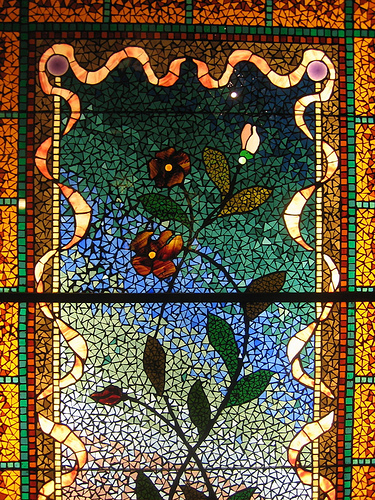
There were at least 22 different patents issued to Henry F. Belcher for his unique processes, though only 4 of them are for the Belcher Mosaic Process. All the patents can be viewed on Google Patents. Every link goes to the Google Patents page for that patent, where you can download a pdf of the full patents, just in case you are a stained glass pack rat, like me.
This is the earliest and the most detailed of the Mosaic patents, plus the first image from that patent -
Mosaic of Glass and Lead Glazing
Henry F. Belcher, of Irvington, New Jersey
Patent number: 303359
Filing date: Oct 21, 1883
Issue date: Aug 1884
Sheet 1 - Mosaic of Glass and Lead Glazing
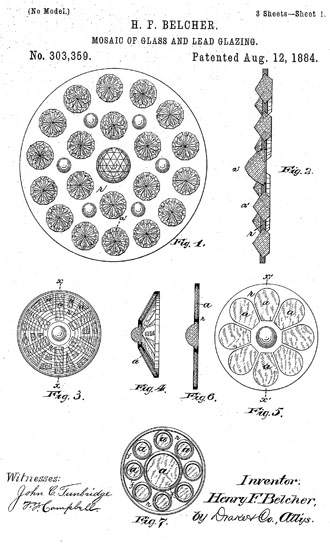
More from this patent, plus the 3 other Mosaic patents, plus a bonus or two after the fold...
The Belcher Mosaic technique features a unique (and devilishly hard to explain) process for making stained glass windows. In this process, glass is laid out on a surface with a gap between each piece of glass. Then another surface is placed on top of it very tightly. The whole thing is placed on its side and molten lead is poured in to fill the gap between the pieces of glass, therefore binding them together. When the two layers of 'surface' are removed there is a solid panel of glass and metal. This is compared to the traditional technique of stained glass where lead came and glass must me assembled piece by piece, then the individual metal pieces are soldered at the joints, and then the gaps cemented in to form a solid panel. The Belcher technique is very much more like a 'mosaic' technique, only using glass and metal rather than tile and grout.
Sheet 2 - Mosaic of Glass and Lead Glazing
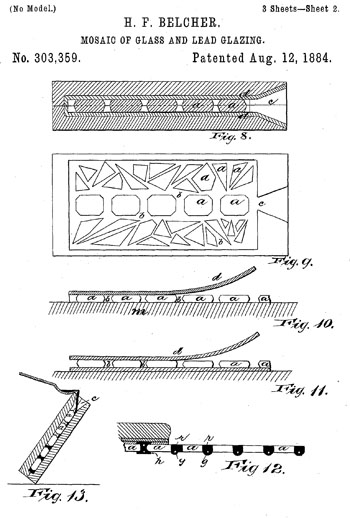
Sheet 3 - Mosaic of Glass and Lead Glazing
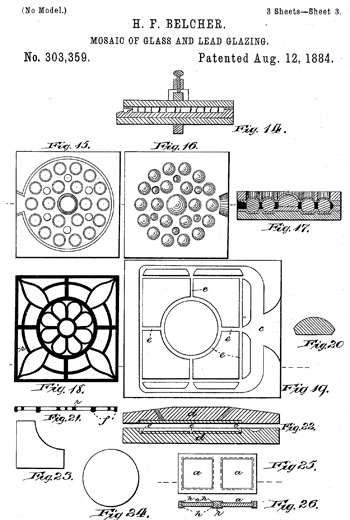
You can see more Belcher Mosaic windows on the webpage from the Michigan Stained Glass Census Window of the Month page for July, 2005. Barbara Krueger, of the Michigan Census, has done extensive research on Belcher Mosaic windows.
Belcher's Post-1884 Mosaic Related Patents
MOSAIC OF GLASS AND LEAD GLAZING
Henry F. Belcher
Patent number: 317077
Issue date: May 1885
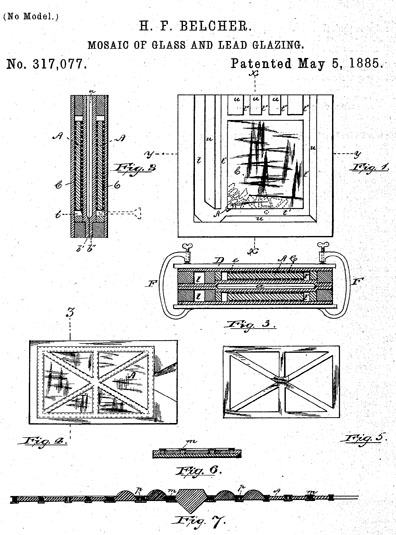
Process of Making Mosaics of Glass
Henry F. Belcher
Patent number: 396911
Filing date: May 11, 1887
Issue date: Jan 1889
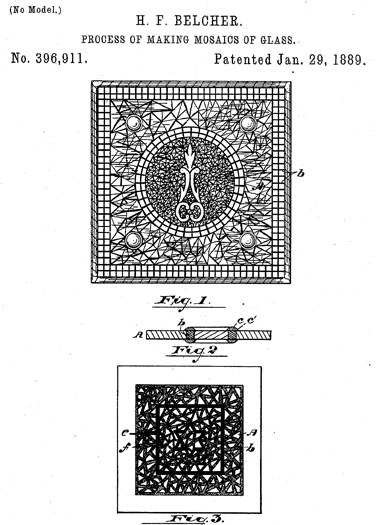
MOLD FOR MAKING MOSAICS
Henry F. Belcher
Patent number: 396912
Filing date: May 11, 1887
Issue date: Jan 1889
Sheet 1 - Mold for Making Mosaics
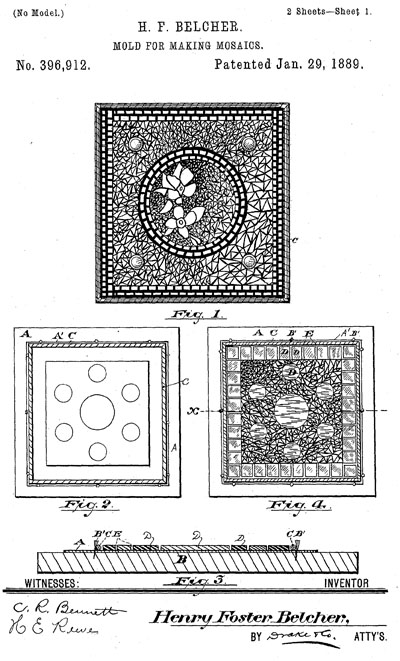
Sheet 2 - Mold for Making Mosaics
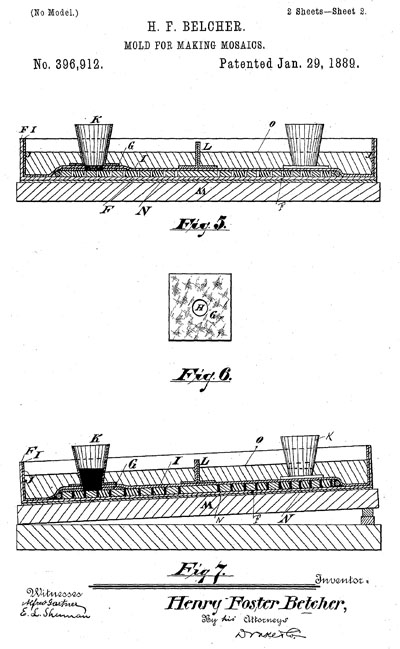
Belcher's Luxfer Prism Patents
Belcher later worked for the Luxfer Prism company where he is credited with developing Prism-lights, with at least 18 Luxfer Prism related patents on Google Patents. The prism patents all boil down to 2 categories, ones that show the glass, and ones that showing framing and mounting systems.
Example of one showing the glass -
DESIGN FOR A PRISM-LIGHT
Henry F. Belcher
Patent number: D27327
Filing date: Jun 15, 1897
Issue date: 1897
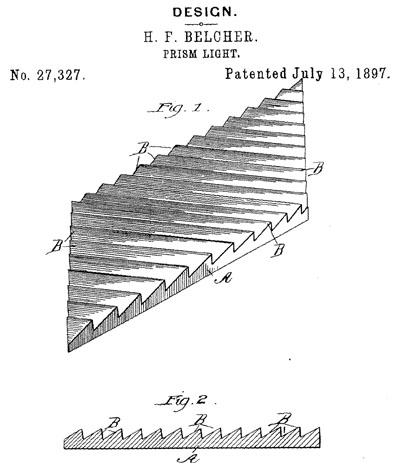
another glass variation
DESIGN FOR A PRISM-LIGHT
Henry F. Belcher
Patent number: D27328
Filing date: Jun 15, 1897
Issue date: Jul 13, 1897
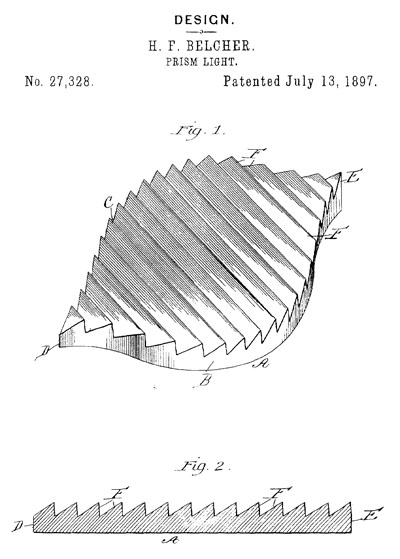
example of one showing a framing system
Method of Mounting Prism-Lights and Ornamental Glass
Henry F. Belcher
Patent number: 586227
Filing date: Apr 19, 1897
Issue date: Jul 1897
another frame/mounting variation -
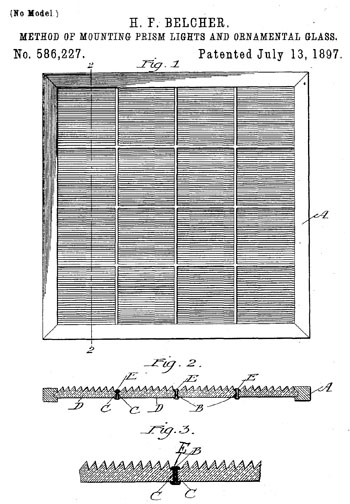
FRAMING PRISM LIGHTS OR TILES
Henry F. Belcher
Patent number: 586229
Filing date: Apr 19, 1897
Issue date: Jul 13, 1897
Sheet 1 - FRAMING PRISM LIGHTS OR TILES
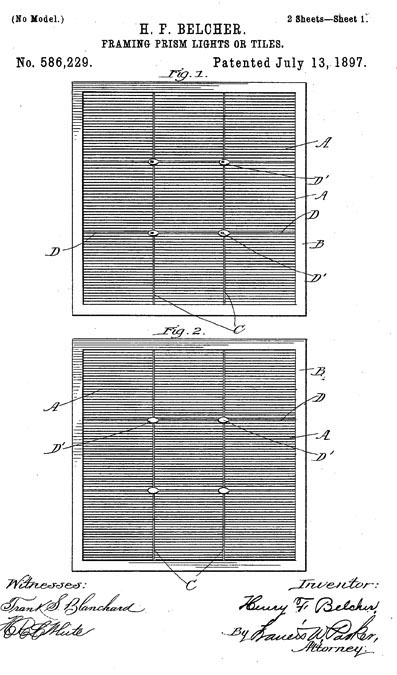
Sheet 2 - FRAMING PRISM LIGHTS OR TILES
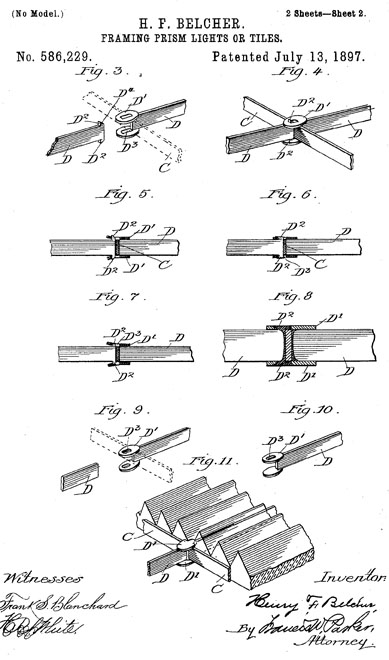
Recent variations on Belcher Mosaic
The Belcher Mosaic window never quite caught on with the general public. Plus, they are notoriously difficult to repair/restore. Nevertheless, there have been a few patents put out since then for processes similar to the Belcher Mosiac, though I do not know if any have actually been made into windows.
This is a recent one, granted less than 10 years ago in 2000, and which cites a number of patents that are, in some ways, similar to the Belcher process.
Method for producing a metal matrix for mosaic structures
Andrew Eisan, Durham NC
Patent number: 6040065
Filing date: Dec 21, 1998
Issue date: Mar 21, 2000
The language on this one is especially obfuscating -
A method for producing a metal matrix (32) which binds inclusions (12,15) in a stable structure (31) so that the surface areas of two opposing sides of each inclusion (12,15) are visible, thus enabling translucency. This method comprises the steps of securing inclusions (12,15) to a temporary...
October 27, 2009
Hey, Get a load of that Strained Glass Window!
I gathered these clips awhile ago, but never managed to post them. I guess that it seemed like I was making too fussy a point to bother posting it. Well, I've been busy and thought I may as well throw these on the blog out of mere curiousity.
It's long bothered me how movies get stained glass windows wrong. Specifically, how they get the idea of how a stained glass window will break wrong. They cannot conceptualize that a stained glass window is a matrix of metal with glass inserts. They show it as if it is a sheet of glass. So the impact of crashing into a stained glass window is done with a big sharp sounding crash and lots of shards of glass breaking apart. The truth is that unless the impact is very great the impact would be with a thud and there would not be shards of glass flying everywhere.
first example -
"Robin Hood, Prince of Thieves", the Kevin Costner version.
The business with the stained glass window is at 3:15. Do yourself a favor and just go straight to that and watch only that. This is an incredibly bad movie no matter how you look at it, and it only gets worse with age.
Even a human body will not shatter a stained glass window like this, especially considering that any stained glass window the size of a human body will have support bars. Kevin Costner would as likely have bounced off the window entirely. Which, considering the quality of the movie, might have been an improvement.
"State and Main" - The actual scene that botches up the effect of breaking the stained glass window is such a small part of the movie that I wouldn't even mention it, except that it is actually mentioned in the dialogue as something of a plot point that the stained glass window in the firehouse is the only thing of value in the town. Again, it breaks as if it is one big sheet of glass, though mercifully there are no exploding shards of glass. At least 'State and Main' is a reasonably watchable movie. Though I would also say it's mostly of interest to hardcore David Mamet fans. David Mamet and comedy just don't seem a comfortable mix, imho.
The set-up for the 'value' of the stained glass window - at 1:38
The window breaking is shown in the trailer at 1:54 -
Pinocchio (1939) - Okay, it's a cartoon, and Disney at that, but I can remember picking up on this even when I was a teenage hobbyist in the 70's. The scene is at 2:20, when Lampwick picks up a brick and hurls it at the 'strained glass window', which shatters like a single sheet of glass. A big tinkling exploding bang. Hey at least this is a genuinely great movie with only a minor annoyance for a nitpicky stained glass artist like me... (not embedded)
October 19, 2009
Sendak-Mania 3 - "I Was There" audio part 2
I was able, over the weekend, to find and digitize the second part of the old audio recording of the mostly Q&A session with Maurice Sendak, from 1983 -
Maurice Sendak at Harvard, 1983 (hour 2).
Again, the file size is big, about 27mb. The sound quality is not great, though not too bad considering this is coming from a 26 year old cassette tape. I actually had to perform surgery on the tape to be able to transfer it. The tape itself was fine, but the tape-case had warped over time, so it wouldn't play. I had to remove the tape and put it into a different case. Very delicate operation, that is.
As I said about part 1, I hadn't remembered him being so funny. The last time I listened to this part of the talk was at least 5 or 6 years ago, and I've heard a number of more recent talks and interviews since then. It's nice to hear him in his prime, when he laughed more at life, but was able to balance it with the intelligence, depth and passion he's known for. I consider the bit about the 'all powerful female mystery' to be pure Sendak - slightly shocking, but insightful and hilarious as well, all the while leaving you with an indelible image.
Like the first part, I broke it down into selected highlights.
you can see below the fold...
all times are approximate -
0:00 - 6:00
Continuing on about The Juniper Tree.
Would you ever illustrate an adult book?
Would you design for Broadway shows as opposed to Opera?
Experience of working in Opera.
6:00 - 12:50
Do kids write you letters?
The Toronto 'Outside Over There' letters
A note from Danny
What is the background for In the Night Kitchen?
12:50 - 24:00
What is the origin of Higglety Pigglety Pop?
What about Pierre?
Where did Pierre come from?
15:00 - 17:20
What responses are there to your books in other countries?
What do think about the translations?
17:20 - 19:30
How do you feel about being famous?
You said you were timid in the past - where were you timid in some of your other books?
19:30 - 24:15
How do you approach set design?
How do you adapt illustration ot set design?
What is your work process for set design?
24:15 - 31:45
Is the story true of an autistic child speaking their first words after exposure to Wild Things?
What was your technique for Zlateh the Goat?
How have you been influenced by comics?
Relates his early job working in comic strips.
Are you still interested in comic strips?
Relates his thoughts on Little Nemo.
and how comic book artists are pigeonholed like children's book artists.
31:45 - 34:00
What kind of things do you think you can do on the stage that you cannot do in children's books?
How much do you think of the audience when you work?
34:00 - 38:30
Do you have contact with other children's book authors and illustrators?
Talks about William Steig, Tomi Ungerer and Dr. Seuss.
Relates his theories on the psychology of Dr. Seuss.
38:30 - 41:30
So do you really just make the work for yourself?
Were you influenced by EC comics?
What about your animated films?
Tells of The animated Really Rosie.
Will you do it again?
41:30 - 49:45
Re: Outside Over There, is there a sexual undertone to it?
What are the things you said you wish you could express, but can't?
Talks about the 'all powerful female mystery'.
How does Outside Over There relate to the set designs for The Magic Flute?
Do you think people will see those things you put into your work?
49:45 - 52:30
Do you feel a need for being socially responsible?
What about social committments?
Did you consciously choose children as models?
52:30 - 54:46
You seem so at ease answering questions - do you do this often?
Do you do a circuit? Or much public speaking?
No, and on that note, I'll stop speaking.
October 17, 2009
Lecture on the the Artistic Journey of Charles J. Connick
Short Notice, but if you are in the Boston area this Sunday you might want to check out a lecture by Albert Tanner called 'Windows are architecture’: William Morris, Viollet-le-Duc, and the Artistic Journey of Charles J. Connick”, at The Church of Our Saviour, 25 Monmouth Street, Longwood, Brookline, Mass., at 2:00 p.m. on Sunday, October 18, 2009. The lectre is co-sponsored by the Connick Foundation. More details in the pdf flyer.
If you want to see a preview of one part of the talk, look at this exchange between Harry Goodhue and Sarah Whitman in these Stained Glass articles in Handicraft, 1903 (this also opens a pdf).
October 16, 2009
The Light Fantastic
I'd heard of this exhibit for at least a year now but I haven't seen any substantial set of images from it, so I didn't see fit to do a post about it. This video gives a better sense of the show than any website I've seen about it.
As a bonus this video gives a fascinating glimpse into how stained glass fits (or doesn't) into contemporary gallery-based art - the mix of light box and natural light pieces, the predominance of mostly abstract work, and the emphasis on innovative technique - all of these shine a light on how stained glass is perceived in the present.
I hadn't heard of any of the artists prior to this exhibit, and I'm not sure there are any who stand out, but see for yourself.
October 14, 2009
Darkness In Light Trailer
The trailer for the documentary film 'Darkness In Light', about the Irish stained glass artist Harry Clarke, directed by John J. Doherty.
There is a good long Movie Review of 'Harry Clarke - Darkness In Light' on blogcritcs.com. I've known of this documentary for awhile but haven't had the chance to see it yet. This very nice trailer will definitely bump it up on the list....
October 13, 2009
Sendak-Mania 2- "I Was There" audio
Setting the scene - It's 1983 and Sendak was at Harvard University for a student theater production of Really Rosie. He was speaking as a part of Harvard's Learning From Performers program, and fortunately for me, it was open to the public. The talk was at Eliot Library, and he spoke and answered questions for 2 hours, standing behind a wingback chair. The place was jam packed and there were people sitting on the floor and standing all along the walls and windows. As I had gotten there early, I was sitting in a nice comfy chair, about 10 feet away from Sendak. After a brief introduction and statement by Sendak, he took questions for nearly 2 hours.
Audio recording of Maurice Sendak at Harvard, 1983.
This was recorded on cassette tape so there are some skips and jumps, but the sound quality, at least of his voice, is surprisingly good. It is hard to hear most of the questions though.
The file should open up whatever sound player you have on your computer, or download it (beware the file is pretty big, nearly 28 mb). I've tried the file on a number of different computers and all seem to handle it fine. This is part 1, and it runs for about an hour. I do have part 2, but it may be awhile before I get to posting it, since that is still on cassette and I've been swamped recently.
I broke it down into selected highlights.
you can see below the fold...
all times are approximate -
0:00 - 11:00
Intro by Learning From Performers person
Sendak gives a brief statement, mostly about his move from print work
into theater work. At the time he was in the midst of doing sets and
costumes for the Pacific Northwest Ballet version of The Nutcracker.
11:00 - 16:45
Being a Children's book author, and what did you read as a child?
16:45 - 24:00
Origins of Outside Over There
His obsession with the Lindbergh Kidnapping case.
Being a sickly child
Askled if there is a formula for writing children's books
Asked how old he was when he learned to read
24:00 - 30:50
Asked about the origins of the Wild Things
and how New York has been an influence on his work
Very funny details of how his Jewish relatives inspired the Wild Things
Also asked why Wild Things was controversial
30:50 - 36:50
Do critics read into your books?
Do you like to read about artist's lives?
What do you think of Sesame Street?
What do you think of socially relevant books for kids?
What have been the hurdles of moving into theater?
36:50 - 42:30
Did you work to obtain a 'style'?
talks about how he doesn't like Arthur Rackham.
art and writing question
How do you fee about the impermanance of the theater compared to print?
42:30 - 48:00
Would you ever illustrate a Wagner opera?
How would you educate children?
What was your art education?
How did you develop your writing talent compared to drawing?
48:00 - 54:50
Relates the experience of photographing children for Outside Over There
Talks about seeing Really Rosie on stage with young adult actors
Asked about illustrating the book The Juniper Tree.
54:50 - 59:45
What is your working routine?
Talks about how his love for bad TV fits into the routine
Asked about the weston woods film of Wild Things
Asked why he thinks The Juniper Tree is such a good story?
So, that's the end of part 1.
On listening to it again, I realized how much of it is really funny. His more recent interviews and appearances have tended to be darker. I've seen Sendak in other personal appearances and events, but this is still my favorite. All the others have been larger and more formal, and therefore, less interesting.
October 06, 2009
Sendak-Mania
Steven Heller interviews Maurice Sendak for Time Out magazine. Just a part of the mad deluge of Sendak related events and articles surrounding the upcoming release of the movie version of Where the Wild Things Are. There is Wild Things Week in New York, including an exhibit at the Morgan Library Where the Wild Things Are: Original Drawings by Maurice Sendak.
I've written about Sendak a number of times on this blog. From my first confession about The Sendak Thing from March 2004, to Yes, I need Tuesday, with a link to an interview in Horn Book Magazine. There is also Sendak's Descent into Limbo – Oct 2005 with a link to a video of him at MIT talking about We are All in The Dumps With Jack and Guy, perhaps my favorite 'Late Sendak' work. Also, Sendak in NYC, centered on an exhibition at the Jewish Museum in New York, and Sendak on NPR, from June 2005. Amazingly, all the links I tried are still live.
I must admit I am very skeptical about the movie, from the trailer and the featurette and the movies I've seen by Spike Jonze. I didn't much like 'Being John Malcovich' (great idea that falls apart in the second half), and liked 'Adaptation' even less.
Still, the marketing campaign for 'Wild Things' has been pretty interesting, especially the blogs like Terrible Yellow Eyes, a blog of 'Wild Things' inspired artwork, and Spike Jonze's own blog about the movie of Wild Things called We Love You So.
[update October 13, 2009 - via Michael Sporn's animation 'splog' - The best Sendak Mania website for images of Sendak sketches is at the Animazing Gallery website, which has a page of art from an exhibit called Sendak in Soho. Very nice stuff.]